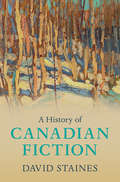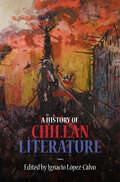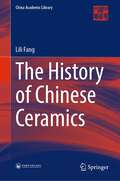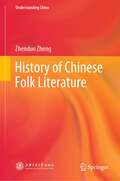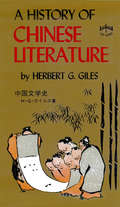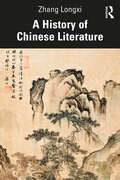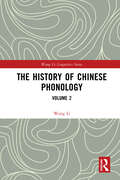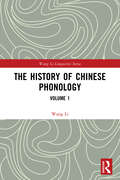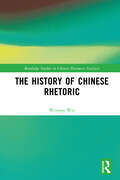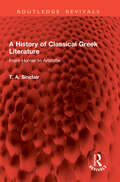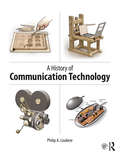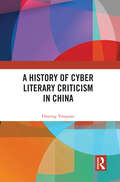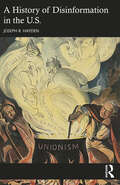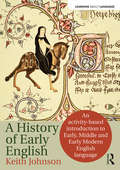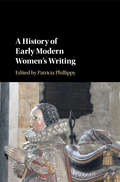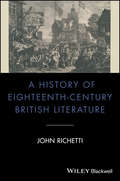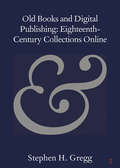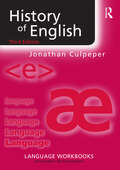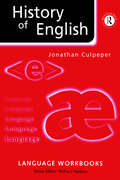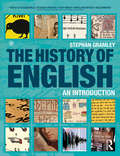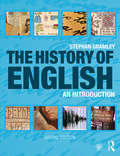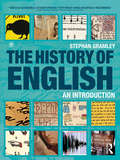- Table View
- List View
A History of Canadian Fiction
by David StainesA History of Canadian Fiction is the first one-volume history to chart its development from earliest times to the present day. Recounting the struggles and the glories of this burgeoning area of investigation, it explains Canada's literary growth alongside its remarkable history. Highlighting the people who have shaped and are shaping Canadian literary culture, the book examines such major figures as Mavis Gallant, Mordecai Richler, Alice Munro, Margaret Atwood, Michael Ondaatje, and Thomas King, concluding with young authors of today whose major successes reflect their indebtedness to their Canadian forbearers.
A History of Chilean Literature
by Ignacio López-CalvoThis book covers the full range and diversity of Chilean literature from the times of the Spanish conquest to the present. By emphasizing transnational, hemispheric, and global approaches to Chilean literature, it reflects the relevance of themes such as neoliberalism, migration and exile, as well as subfields like ethnic studies, and gender and sexuality studies. It showcases the diversity of Chilean literature throughout all periods, regions, ethnocultural groups and social classes, all the while foregrounding its regional variations. Unlike previous literary histories, it maps a rich heterogeneity by including works by Chileans of indigenous, African, Jewish, Arab, Asian, and Croatian ancestries, as well as studies of literature by LGTBQ authors and Chilean Americans. Ambitious and authoritative, this book is essential reading for scholars of Chilean Literature, Latin American Literature, the Global South, and World Literature.
The History of Chinese Ceramics (China Academic Library)
by Lili FangAdopting the perspective of anthropology of art and combining it with global academic insights, this book helps the readers to recognize that “history is, in great measure, the record of human activity which spreads from the local to the regional, from the regional to the global, and from the global to the universal.” Readers will learn that China was not only the first country to create porcelain, but also the first to export it to the world, both the products and its techniques. Therefore, the history of Chinese ceramics reflects the history of Chinese foreign trade on the one hand and depicts the expansion of Chinese ceramic techniques and cultures on the other. In addition to ceramics types, molds, decoration, and techniques, the book analyzes the spiritual impacts and aesthetic conceptions embodied in the utensils of daily use by the Chinese literati. Therefore, it reaches the conclusion that ideological systems and not technological systems are what bring about social revolutions. In addition, the book is richly illustrated with pictures of earthenware and finely glazed pieces from later periods.
History of Chinese Folk Literature (Understanding China)
by Zhenduo ZhengThis book mainly addresses the position, function, influence, and values of folk oral literature in the history of Chinese literature. Divided into 14 chapters, it systematically covers central aspects of folklore literature such as ballads, folk songs, Bianwen, Zajuci, Guzici, Zhugongdiao, Sanqu, Baojuan, Tanci, Zidishu, and so on from the Pre-Qin to the late Qing Dynasties, filling several gaps in literary history studies. It is a comprehensive literary work, and many of the materials cited here are rare and difficult to find. In addition, the book proposes some important theories, especially six highly generalized qualities of folk literature, namely that it is: popular, collective, oral, fresh, effusive, and innovative.With detailed, extensive materials, and quotations, the book represents the most systematic and comprehensive work to date on ancient Chinese folk literature. It is mutually complementary with Guowei Wang’s A Textual Research of the Traditional Chinese Opera in the Song and Yuan Dynasties and Xun Lu’s A Brief History of Chinese Fiction; all three works are regarded as the most essential classics for researching the history of Chinese literature.
A History of Chinese Literature
by Herbert G. GilesA History of Chinese Literature is THE classic introduction to Chinese literature, which has given to the world exquisite poetry and such classics as Monkey, The Analects of Confucius, the works of Chuang Tzu, and other writings over a time span of 2,500 or more years.<P><P>Author, Professor Giles, a legendary scholar of Chinese, was best known for the Wade-Giles romanization system. In this book he considered all forms of Chinese literature including: prose, poetry, the novel, the short story, drama, and scientific writing. The material is organized chronologically into eight books which are in turn divided into subject chapters. The arrival of Buddhism to China, the invention of printing, and other significant events are admirably outlined. Whoever reads this excellent introduction will be hungry for more of the literary products of China.A History of Chinese Literature provides us with a capsule guide to 2,500 years of Chinese culture. Remote as ancient literature may seem to Chinese manners today, the traditional literature does in fact provide a key to modern China and to Chinese communism. This populous nation, which represents the world's oldest living civilization, is in reality still close to its own past philosophies and ideals.
A History of Chinese Literature
by Zhang LongxiZhang Longxi, an internationally renowned scholar of Chinese and comparative literature, is your guide to the three-millennia-long history of Chinese literature from the remote antiquity of oracle bones to contemporary works. Professor Zhang charts the development of the major literary forms in Chinese, including poetry, prose, song lyrics, and plays, and introduces the most famous poets and writers and their representative texts. Taking a period-based approach through the major dynasties, he places these forms, texts, and authors within their historical contexts and tells the fascinating story of Chinese literature with copious examples in English translation. He writes in a clear and accessible style and assumes no prior knowledge of Chinese history or Chinese literature. This book is an ideal introduction for students and the general readers who want to get a broad but thorough overview of Chinese literature in all its richness and diversity.
A History of Chinese Literature
by Zhang LongxiZhang Longxi, an internationally renowned scholar of Chinese and comparative literature, is your guide to the three-millennia-long history of Chinese literature from the remote antiquity of oracle bones to contemporary works. Professor Zhang charts the development of the major literary forms in Chinese, including poetry, prose, song lyrics, and plays, and introduces the most famous poets and writers and their representative texts. Taking a period-based approach through the major dynasties, he places these forms, texts, and authors within their historical contexts and tells the fascinating story of Chinese literature with copious examples in English translation. He writes in a clear and accessible style and assumes no prior knowledge of Chinese history or Chinese literature. This book is an ideal introduction for students and the general readers who want to get a broad but thorough overview of Chinese literature in all its richness and diversity.
The History of Chinese Phonology: Volume 2 (Wang Li Linguistics Series)
by Wang LiAs the second volume of a two-volume set on the history of Chinese phonology, this book studies the history of phonology from the Yuan dynasty until modern times and discusses the four approaches of sound change.Based on abundant phonological materials, the author divides the history of Chinese phonology into nine historical periods, which helps illuminate its evolutions and principles. Following on from the first volume, the first part of this second volume deals with the initials, rhymes, and tones of Chinese phonology from the Yuan dynasty (1279–1368) to modern times (since 1911), illustrating the diachronic sound changes with detailed tables. Based on an historical review of Chinese phonology, the second part of the book classifies sound changes via four major approaches: no change, gradual shift, split, and merger. It then analyzes the natural, conditional, and irregular sound changes, respectively, and the reasons for these changes.This title will be of great value for scholars and students studying Chinese phonology and Chinese linguistics, and readers interested in the essence of rhyming behind Chinese classic lyrics, poetry, drama, and other forms of verse.
The History of Chinese Phonology: Volume 1 (Wang Li Linguistics Series)
by Wang LiAs the first volume of a two-volume set on the history of Chinese phonology, this book introduces the basics of the discipline and charts the history of phonology from the pre-Qin period to the Song dynasty.Based on abundant phonological materials, the author divides the history of Chinese phonology into nine historical periods, which helps illuminate its evolutions and principles. The first part of the book explains the fundamental concepts of the history and studies of Chinese phonology, including the rhyme dictionary, the rhyme table, dialect, and methodology, as well as fanqie, rhyme sets, division, and articulation. The second part discusses Chinese phonology across the first six periods, from the pre-Qin era (before 206 BCE) to the Song dynasty (960–1279), elucidating the phonological development and characteristics in terms of initials, rhyme groups, and tones.This title will be of great value for scholars and students studying Chinese phonology, Chinese linguistics, and readers interested in the essence of rhyming behind classic Chinese lyrics, poetry, drama, and other forms of verse.
The History of Chinese Rhetoric (Routledge Studies in Chinese Discourse Analysis)
by Weixiao WeiThis book challenges the existing misconception that there was no rhetoric in ancient China. Instead, this book provides ample evidence from public speeches in the Xia dynasty and oracle bone inscriptions in the Shang dynasty to public debates about government policies in the Han dynasty to show that persuasive discourse and rudimentary rhetorical techniques already existed in ancient China. Using literary analysis and discourse analysis methods, this book explains how the Mandate of Heaven was inscribed at the core of Chinese rhetoric and has guided Chinese thoughts and expressions for centuries. This book also demonstrates Chinese rhetorical wisdom by extracting many concepts and terms related to language expression, persuasive speech, morality and virtue, life and philosophy, and so on from great Chinese literary works. Well-known names, such as Confucius, Laozi, Sima Qian, Liu Xie, Mozi, Hanfeizi, Guibuzi and so on, are all touched upon with their famous theory and sayings related to and explicated from the rhetorical perspective. Many surprising facts are found by the author and revealed in the book. For example, a thousand years ago, the Chinese author Liu Xie already found that all words have preferred lexical neighbors and structural environment. This is later on ‘discovered’ by corpus linguistics and illustrated, for example, by the concepts of collocation and pattern grammar. This book targets postgraduate students, teachers, researchers and scholars interested in advanced Chinese language and Chinese literature, history, and culture.
A History of Classical Greek Literature: From Homer to Aristotle (Routledge Revivals)
by T. A. SinclairFirst Published in 1934, this book gives a general survey of the history of classical Greek literature from Homer to Aristotle. It discusses important themes like Homeric criticism and the Homeric question; elegiac poetry; lyric poetry; myth and history in verse; Heraclitus and philosophy in prose; the scientific study of history; origins of tragedy; origins of comedy; changes in the fourth century; and Aristotle and the end of the classical period. This is a must read for students of Greek literature and history of classical literature.
A History of Colombian Literature
by Raymond Leslie WilliamsIn recent decades, the international recognition of Nobel Laureate Gabriel García Márquez has placed Colombian writing on the global literary map. A History of Colombian Literature explores the genealogy of Colombian poetry and prose from the colonial period to the present day. Beginning with a comprehensive introduction that charts the development of a national literary tradition, this History includes extensive essays that illuminate the cultural and political intricacies of Colombian literature. Organized thematically, these essays survey the multilayered verse and fiction of such diverse writers as José Eustacio Rivera, Tomás Carrasquilla, Alvaro Mutis, and Darío Jaramillo Agudelo. Written by a host of leading scholars, this History also devotes special attention to the lasting significance of colonialism and multiculturalism in Colombian literature. This book is of pivotal importance to the development of Colombian writing and will serve as an invaluable reference for specialists and students alike.
A History of Communication Technology
by Philip LoubereThis book is a comprehensive illustrated account of the technologies and inventions in mass communication that have accelerated the advancement of human culture and society. A History of Communication Technology covers a timeline in the history of mass communication that begins with human prehistory and extends all the way to the current digital age. Using rich, full-color graphics and diagrams, the book details the workings of various mass communication inventions, from paper-making, printing presses, photography, radio, TV, film, and video, to computers, digital devices, and the Internet. Readers are given insightful narratives on the social impact of these technologies, brief historical accounts of the inventors, and sidebars on the related technologies that enabled these inventions. This book is ideal for students in introductory mass communication, visual communication, and history of media courses, offering a highly approachable, graphic-oriented approach to the history of communication technologies.
A History of Communications
by Marshall T. PoeA History of Communications advances a new theory of media that explains the origins and impact of different forms of communication – speech, writing, print, electronic devices and the Internet – on human history in the long term. New media are 'pulled' into widespread use by broad historical trends and these media, once in widespread use, 'push' social institutions and beliefs in predictable directions. This view allows us to see for the first time what is truly new about the Internet, what is not, and where it is taking us.
A History of Cyber Literary Criticism in China
by Ouyang YouquanThis is the first scholarly attempt to write a history of cyber literary criticism in China. The author uses the Internet as the departure point, literature as the horizontal axis, and criticism as the vertical axis, to draw a detailed trajectory of the development of cyber literary criticism in China.The book comprises two parts. The first part focuses on the representation of historical facts about cyber literary criticism, covering five topics: the evolution of cyber literary criticism in the context of the new media; major types of cyber literary critics and their criticism; academic achievements in cyber literary studies; the form, contents, and rhetorical expressions of so-called netizens’ critical commentaries; and important events in the history of cyber literary criticism. The second part discusses the historical changes in literary criticism as responses to cyber literature, covering another five topics: the conceptual transformation in literary criticism of the Internet era; the establishment of evaluation criteria for cyber literature; changes in the function of cyber literary criticism; changes in the constitution of cyber literary critics; and the impact of cyber literary criticism. This book will be an essential read to students and scholars of East Asian Studies, literary criticism, and those who are interested in cyber literature in general.
A History of Disinformation in the U.S.
by Joseph R. HaydenThis volume recounts notable episodes of distortion throughout American media history. It examines several of the lurid hoaxes and conspiracy theories that have inspired press coverage, as well as some of the political lies promoted by partisan gladiators, whether of the eighteenth century or today.The book moves beyond the sensational stories to show the enduring and systemic nature of media manipulation that occurs on far more consequential issues. It exposes persistent and deeply destructive falsehoods that have been told about women, people of color, immigrants, the LGBTQ+ community, unions, commercial products, highlighting how longstanding “bipartisan” myths have effectively marginalized certain groups of Americans. Alongside these cases, the author carefully dissects the changing nature of institutions, technologies, and practices of journalism in America. Attention is given to the evolution of newspapers in the eighteenth and nineteenth centuries, the role of broadcasting in the twentieth, and the impact of the internet and social media at the dawn of the twenty-first.This book will appeal to readers interested in American history, journalism, communication studies, political science and sociology.
The History of Early English: An activity-based approach (Learning about Language)
by Keith JohnsonThe History of Early English provides an accessible and student-friendly introduction to the history of the English language from its beginnings until the end of the Early Modern English period. Taking an activity-based approach, this text ensures that students learn by engaging with the fascinating evolution of this language rather than simply reading about it. The History of Early English: Provides a comprehensive introduction to early, middle and early modern English; Introduces each language period with a text from writers such as Chaucer and Shakespeare, accompanied by a series of guiding questions and commentaries that will engage readers and give them a flavour of the language of the time; Features a range of activities that include discussion points, questions, online tasks and preparatory activities that seamlessly take the reader from one chapter to the next; Is supported by a companion website featuring audio files, further activities and links to online material. Written by an experienced teacher and author, this book is the essential course textbook for any module on the history of English.
A History of Early Modern Women's Writing
by Patricia PhillippyA History of Early Modern Women's Writing is essential reading for students and scholars working in the field of early modern British literature and history. This collaborative book of twenty-two chapters offers an expansive, multifaceted narrative of British women's literary and textual production in the period stretching from the English Reformation to the Restoration. Chapters work together to trace the contours of a diverse body of early modern women's writing, aligning women's texts with the major literary, political, and cultural currents with which they engage. Contributors examine and take account of developments in critical theory, feminism, and gender studies that have influenced the reception, reading, and interpretation of early modern women's writing. This book explicates and interrogates significant methodological and critical developments in the past four decades, guiding and testing scholarship in this period of intense activity in the recovery, dissemination, and interpretation of women's writing.
A History of Eighteenth-Century British Literature
by John RichettiA History of Eighteenth-Century British Literature is a lively exploration of one of the most diverse and innovative periods in literary history. Capturing the richness and excitement of the era, this book provides extensive coverage of major authors, poets, dramatists, and journalists of the period, such as Dryden, Pope and Swift, while also exploring the works of important writers who have received less attention by modern scholars, such as Matthew Prior and Charles Churchill. Uniquely, the book also discusses noncanonical, working-class writers and demotic works of the era. During the eighteenth-century, Britain experienced vast social, political, economic, and existential changes, greatly influencing the literary world. The major forms of verse, poetry, fiction and non-fiction, experimental works, drama, and political prose from writers such as Montagu, Finch, Johnson, Goldsmith and Cowper, are discussed here in relation to their historical context. A History of Eighteenth-Century British Literature is essential reading for advanced undergraduates and graduate students of English literature. Topics covered include: Verse in the early 18th century, from Pope, Gay, and Swift to Addison, Defoe, Montagu, and Finch Poetry from the mid- to late-century, highlighting the works of Johnson, Gray, Collins, Smart, Goldsmith, and Cowper among others, as well as women and working-class poets Prose Fiction in the early and 18th century, including Behn, Haywood, Defoe, Swift, Richardson, Fielding, and Smollett The novel past mid-century, including experimental works by Johnson, Sterne, Mackenzie, Walpole, Goldsmith, and Burney Non-fiction prose, including political and polemical prose 18th century drama
The History of Eighteenth-Century Collections Online (Elements in Publishing and Book Culture)
by Stephen H. GreggThis is a history of Eighteenth-Century Collections Online, a database of over 180,000 titles. Published by Gale in 2003 it has had an enormous impact of the study of the eighteenth century. Like many commercial digital archives, ECCO's continuing development obscures its precedents. This Element examines its prehistory as, first, a computer catalogue of eighteenth-century print, and then as a commercial microfilm collection, before moving to the digitisation and development of the interfaces to ECCO, as well as Gale's various partnerships and licensing deals. An essential aspect of this Element is how it explores the socio-cultural and technological debates around the access to old books from the 1930s to the present day: Stephen Gregg demonstrates how these contexts powerfully shape the way ECCO works to this day. The Element's aim is to make us better users and better readers of digital archives.
History of English (Language Workbooks)
by Jonathan CulpeperRoutledge Language Workbooks provide absolute beginners with practical introductions to core areas of language study. Books in the series provide comprehensive coverage of the area as well as a basis for further investigation. Each Language Workbook guides the reader through the subject using ‘hands-on’ language analysis, equipping them with the basic analytical skills needed to handle a wide range of data. Written in a clear and simple style, with all technical concepts fully explained, Language Workbooks can be used for independent study or as part of a taught class. History of English: • examines the history of the English language in order to explain the English that is used today • introduces key linguistic concepts • provides ‘discussion points’ to generate debate • encourages readers to think critically about the subject • involves readers in collecting and analysing their own data • contains a ‘mini-corpus’ of texts, used for exercises and to illustrate points raised in the commentary Revised throughout, this updated edition integrates the latest research on the history of English, including an additional chapter on English letters and punctuation, and an updated bibliography. History of English, 3rd edition provides an essential introduction and workbook for students coming to this subject for the first time.
History of English (Language Workbooks)
by Jonathan CulpeperHistory of English: * covers the development of the English language from the 5th century to the present day* contains a `mini-corpus' of texts, used for exercises and to illustrate points raised in the commentary* introduces key linguistic concepts* provides `discussion points' to generate debate* involves readers in collecting and analysing their own data
The History of English: An Introduction
by Stephan GramleyThe History of English: An Introduction provides a chronological analysis of the linguistic, social, and cultural development of the English language from before its establishment in Britain around the year 450 to the present. Each chapter represents a new stage in the development of the language from Old English through Middle English to Modern Global English, all illustrated with a rich and diverse selection of primary texts showing changes in language resulting from contact, conquest and domination, and the expansion of English around the world. The History of English goes beyond the usual focus on English in the UK and the USA to include the wider global course of the language during and following the Early Modern English period. This perspective therefore also includes a historical review of English in its pidgin and creole varieties and as a native and/or second language in the Caribbean, Africa, Asia, and Australasia. Designed to be user-friendly, The History of English contains: chapter introductions and conclusions to assist study over 80 textual examples demonstrating linguistic change, accompanied by translations and/or glosses where appropriate study questions on the social, cultural and linguistic background of the chapter topics further reading from key texts to extend or deepen the focus nearly 100 supporting figures, tables, and maps to illuminate the text 16-pages of colour plates depicting exemplary texts, relevant artefacts, and examples of language usage, including Germanic runes, the opening page of Beowulf, the New England Primer, and the Treaty of Waitangi. The companion website at www.routledge.com/cw/gramley supports the textbook and features: an extended view of major aspects of language development as well as synopses of material dealt with in a range of chapters in the book further sample texts, including examples from Chaucer, numerous Early Modern English texts from a wide variety of fields, and twenty-first-century novels additional exercises to help users expand their insights and apply background knowledge an interactive timeline of important historical events and developments with linked encyclopaedic entries audio clips providing examples of a wide range of accents The History of English is essential reading for any student of the English language.
The History of English: An Introduction
by Stephan GramleyThe History of English: An Introduction provides a chronological analysis of the linguistic, social, and cultural development of the English language from before its establishment in Britain around the year 450 to the present. Each chapter represents a new stage in the development of the language from Old English through Middle English to Modern Global English, all illustrated with a rich and diverse selection of primary texts showing changes in language resulting from contact, conquest and domination, and the expansion of English around the world. The History of English goes beyond the usual focus on English in the UK and the USA to include the wider global course of the language during and following the Early Modern English period. This perspective therefore also includes a historical review of English in its pidgin and creole varieties and as a native and/or second language in the Caribbean, Africa, Asia, and Australasia. This new edition of The History of English has been thoroughly revised and updated throughout, and features: chapter introductions and conclusions to assist in orientation; over 90 textual examples demonstrating linguistic change accompanied, as necessary, by translations and/or glosses; study questions on the social, cultural, and linguistic background of the periods and topics, as well as recommendations for further reading and topics for further study; over 100 figures, tables and maps to support and illuminate the text; 18 pages of colour plates depicting exemplary texts, relevant artifacts, and examples of language usage, including Germanic runes, the opening page of Beowulf, the New England Primer, and the Treaty of Waitangi; a brand-new companion website hosting further articles on linguistic, historical, and cultural phenomena which go beyond the scope of the book, additional sample texts, exercises, and audio clips. The History of English is essential reading for any student of the English language, and will be of relevance to any course addressing the origins of the English language.
The History of English: An Introduction
by Stephan GramleyThe History of English: An Introduction provides a chronological analysis of the linguistic, social, and cultural development of the English language from before its establishment in Britain around the year 450 to the present.
